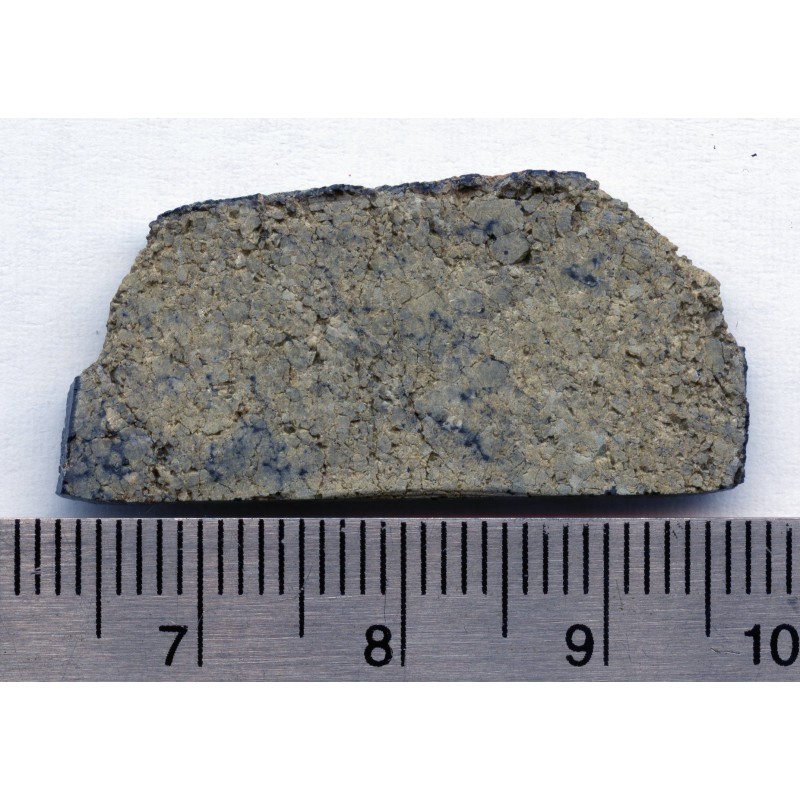



Part slice with fusion crust
Weight: 3.479 g Size: 35 x 15 mm (thickness is 2 mm)
The NWA 8694 is a chassignite and the missing link between the Chassignites and Nakhlites.
NORTHWEST AFRICA 8694, A FERROAN CHASSIGNITE. R.H. Hewins1,2, B. Zanda1,2, S. Pont1, M. Hu- mayun.3, N. Assayag3 and P. Cartigny3. 1IMPMC, MNHN, 75005 Paris, FR. 2Rutgers University, Piscataway, NJ
08854, USA. 3Florida State University, Tallahassee, FL 32310, USA. 4IPGP, Univ. Paris Diderot, F-75005 Paris, FR.
http://www.hou.usra.edu/meetings/lpsc2015/pdf/2249.pdf
From the Meteoritical Bulletin > http://www.lpi.usra.edu/meteor/metbull.php?code=61276
Northwest Africa 8694 (NWA 8694)
Morocco
Purchased: 14 July 2014
Classification: Martian meteorite (Chassignite)
Physical characteristics: A single flattened spherical stone, almost entirely covered by fusions crust.
Petrography: (R. Hewins, S. Pont, B. Zanda, MNHNP) This meteorite is a cumulate dunite with 85% highly fractured olivine. It has an adcumulate texture with small patches rich in interstitial material having an orthocumulate texture. The main intercumulus phases are pigeonite and augite, both with very fine (1 μm) exsolution lamellae,and glass. Minor phases include chromite, partly enclosed by olivine, and ilmenite. The olivine contains largely crystalline melt inclusions, surrounded by radial fractures. The main phases in melt inclusions are orthopyroxene and glass; rare phases include apatite, amphibole and mica.
Geochemistry: Mineral compositions: (R. Hewins, MNHNP) The olivine composition is Fo53.2±0.3Fa46.8±0.3, with an FeO/MnO ratio of 50.0±1.6, n=24. The crystals are equilibrated in Fe-Mg, but retain a weak depletion of Ca towards crystal rims, with a total range of 0.8–0.29 wt. % CaO. The pigeonite composition is En55.8±0.9Fs37.5±1.0Wo6.7±1.3, n=26, and FeO/MnO of 28.7±1.9; the orthopyroxene is En59.9±0.4Fs37.7±0.9Wo2.4±0.8 and FeO/MnO ratio of 30.2±3.0; and the augite is En40.6±0.2Fs16.1±0.6Wo43.3±0.5, with an FeO/MnO ratio of 27.4±3.2, (neglecting overlap compositions). The orthopyroxene in the melt inclusions varies from En56 to En59, with Al2O3 up to 4 wt.%, whereas interstitial orthopyroxene has only 0.4±0.3 wt.% Al2O3. The amphibole is calcium-rich with 3% TiO2 and the mica is phlogopitic. Apatite has about 2.5 wt.% of each of F and Cl. Geochemistry: (N. Asseyag, P. Cartigny, IPGP). Oxygen isotope analysis gives δ18O=4.74 δ17O=2.78 Δ17O=0.32, (standard errors: ±0.10, ±0.07, ±0.04 respectively).
Classification: (R. Hewins, S. Pont and B. Zanda, MNHNP) The meteorite is classified as a chassignite. The textures and mineral assemblages are almost identical to those of Chassigny and NWA 2737. The olivine and pyroxene compositions are intermediate between those of Chassigny and Nakhla. The Fe/Mn ratios of olivine grains fall on to just above the Papike reference line for Mars.
Specimens: Specimen: 12.3 g at MNHNP

Part slice with fusion crust
Weight: 3.479 g Size: 35 x 15 mm (thickness is 2 mm)
The NWA 8694 is a chassignite and the missing link between the Chassignites and Nakhlites.